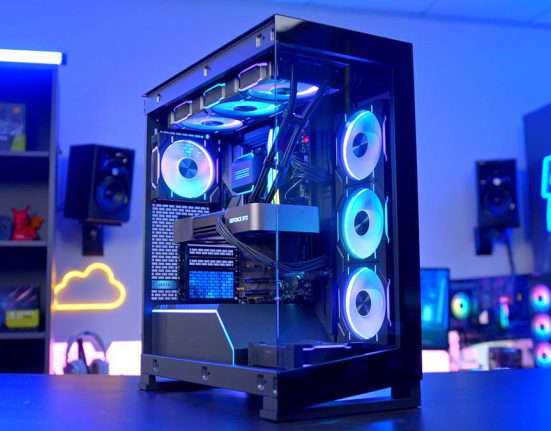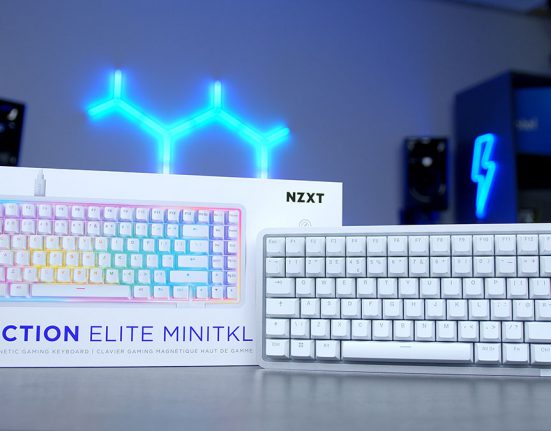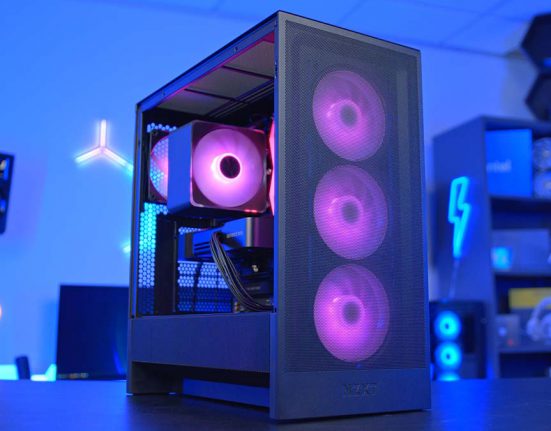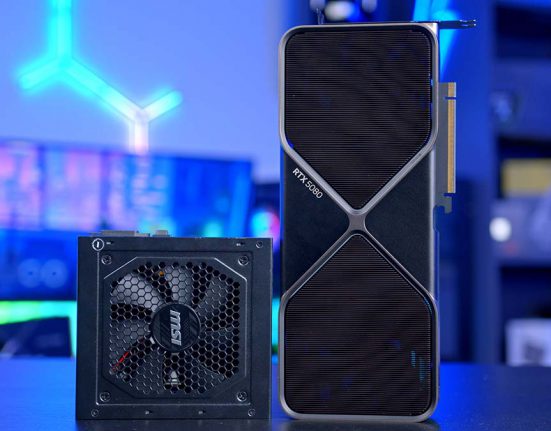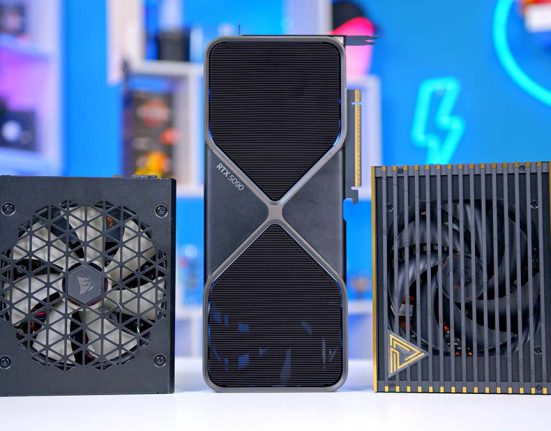The NZXT H5 Flow RGB chassis is the 2024 revision of the H5 Flow series, released in October 2022. This iteration aligns the design language with the 2024 H7 Flow, streamlining the look and improving internal clearance to accommodate better cooling support, airflow, and space for larger motherboards. We’ve tested H5 Flow rigorously in various PC builds and benchmarks to see how it fares compared to previous iterations.
While the H5 Flow looks to improve upon its previous designs by a fair margin, the original case wasn’t received as well during its initial launch. Due to airflow problems, a weak angled GPU fan, and a high price point, the original H5 Flow and its 2023 version haven’t been the most popular cases from NZXT. However, we’ll be curious to see how the 2024 version improves upon the weaknesses of its predecessors to bring a more well-rounded case to the market.
This PC case review examines the H5 Flow in-depth, comparing its specs to those of the 2023 and 2022 iterations. We’ll also explore the design, building quality, and features to determine its value proposition.
Specification
The H5 Flow series of cases is designed as a compact chassis built to house a solid range of configurations. We can draw some direct parallels between the H7 and H5 Flow. For example, the traditional ‘metal box’ look appears in both cases, contrasting with the stark number of fish tank cases that have hit the shelves in the past couple of years. The benefit is that air flows in a standardised way (drawing in from the front and exhausting at the back). So, with the proper amount of ventilation, thermals can be excellent.
While the case’s footprint has remained unchanged compared to the older versions, internal space has been shifted to accommodate more components. The H5 Flow 2024 can now support E-ATX motherboards and a 360mm liquid cooler at the front of the case. Both the 2022 and 2023 iterations of the H5 Flow only had space for up to ATX boards and 280mm radiators, so this opens up options for those building a compact but high-end PC.

Fan support has also improved due to the improved internal space. Now, the front of the case supports up to three 120mm fans instead of two 140mm fans. The top of the case also accommodates two 140mm fans or a 280mm AIO (all-in-one) liquid cooler with low-profile memory. Furthermore, the PSU cover has space for two 120mm fans instead of the angled GPU fan pre-installed in the chassis. This is a very welcomed change, as it leads to more efficient airflow.
| Specification | NZXT H5 Flow |
|---|---|
| Form Factor | Mid-Tower |
| Motherboard Support | Mini-ITX, Micro-ATX, ATX, E-ATX |
| Case Dimensions (L x W x H) | 430mm x 225mm x 465mm |
| Front IO | 1 x USB 3.2 Type-A 1 x USB 3.2 Type-C 1 x 3.5mm Combo Jack |
| PCI-E Slots | 7 |
| Colour | Black White |
| Max Clearance | 170mm Cooler Height 410mm GPU Length 200mm PSU Length |
| Drive Support | Up to 2 x 2.5 inch Up to 1 x 3.5 inch |
| Fan Support | Front: 3 x 120mm Top: 2 x 140mm Bottom: 2 x 120mm Rear: 1 x 120mm |
| Radiator Support | Front: Up to 360mm Top: Up to 240mm (280mm with low-profile memory) |
| Pre-Installed Fans | 2 x 120mm |
| MSRP | H5 Flow (2024): $94.99 H5 Flow RGB (2024): $124.99 |
PSU and CPU cooler clearance have improved slightly. There’s now space for a 170mm tall air cooler and power supplies up to 200mm long. GPU space is where things have shifted by a fair amount. Compared to the 2023 and 2022 H5 Flow cases, there is 45mm of extra space, jumping to 410mm instead of 365mm. This is great to see as modern GPUs have only increased in size, so this opens up space for larger cards like the AMD RX 7900 XTX and NVIDIA RTX 4080 SUPER.
Otherwise, the rest of the case specs remain the same as in previous versions. The amount of IO hasn’t changed. There are two USB ports, one type-A and one type-C, but the generation isn’t specified. The RGB version of the case comes with a single 360mm unit of fans at the front. The non-RGB model only has two fans, one at the front and one at the rear.

Regarding pricing, I think the $94.99 MSRP for the non-RGB version of the case is a fair ask. There aren’t many compact cases available at this price point other than the Fractal Design Pop Mini Air, which is a chassis that doesn’t have space for E-ATX boards or 360mm liquid coolers. There are alternatives like the Phanteks XT Pro Ultra or the Montech King 95 (non-pro), but neither of these is what you’d call small form factor. The RGB version at $124.99 is more problematic because more unique cases are available at this price point, but as a compact case, the H5 Flow looks to be a solid pickup.
NZXT H5 Flow Design
To put it plainly, the H5 Flow 2024 edition is a more compact iteration of the H7 Flow, utilising a somewhat standard-looking box layout. While some prospective buyers may view this design as boring, it’s good to see that the H5 Flow has retained its original style. While the original H5 Flow features needed refinement, the sophisticated aesthetic is a central selling point for this case. The H5 Flow is well-constructed and looks robust. The black colouring is consistent across all panelling and the front IO cables.
Like the 2022 and 2023 iterations, the H5 Flow features a single-tempered glass side panel. Like the rest of the panels around the chassis, this panel is tool-less, making building with the H5 Flow a very straightforward process.

The front panel of the H5 Flow is heavily ventilated and features a fine mesh which minimises blockages and helps reduce dust particles. The PSU shroud and top panel also feature the same mesh design.
The opposing side panel only features ventilation on the bottom third. It would be great to see more ventilation coverage on the side panel, allowing more hot air to flow out of the back of the case.

Opening up the case, you’ll spot some exciting design changes compared to the older models. The first is the ventilated power supply shroud. The entire side of the shroud features a mesh design, while the top has two spots to mount 120mm fans.

The second is that the front-mounted fan takes up space inside the main chamber of the case. Front fans usually sit outside of the case, covered by a panel. On the H5 Flow, the front panel isn’t recessed and sits flush with the rest of the case. While this won’t affect performance, it does look slightly odd.

Spinning the case around to the other side panel, cable management is quite tight here. The cable management bar has a distinct channel behind it, where most cables need to be funnelled. This case has far fewer cutouts than the H7 Flow, which is bound to make cable management harder. Additionally, builders must ensure cable management is done well in this case, as the clearance at the back is pretty small.

The power supply area has more space than the older H5 Flow models. Because there isn’t a fan, there is more room for cables. There is a small drive bay, which can be easily removed by loosening the thumbscrew.
The feet design of the H5 Flow aligns with what we saw on the H7 Flow. Instead of four feet offset from the corners of the case, NZXT has opted for a seamless design, where the feet are flush with the front and rear panels. I’m not a massive fan of the change because it looks slightly strange, but it will appeal to some.

Finally, regarding the case IO, the amount and type haven’t changed compared to the 2023 and 2022 versions of the H5 Flow. However, the IO is now aligned with the side panel instead of sitting horizontally with the front panel. It would be nice to see a couple of extra ports here, but given that the H5 Flow is supposed to be a cheaper case, we can understand why there are only a couple of ports.

Building in the NZXT H5 Flow
From a glance at the design and specs, the H5 Flow 2024 version offers some unique design changes compared to its predecessors, which makes it worth considering. But the best way to ascertain the quality of a case is, quite simply, to build with it. We decided to pair the NZXT H5 Flow with the AMD RX 7900 GRE, APNX AP1-V CPU cooler, and a range of other excellent parts to give us an idea of what building a PC inside this chassis is like.
Internal Space
While the space inside the H5 Flow has increased compared to its older iterations, this is still a compact case, so it is more challenging to work with than a traditional ATX size.
Getting the motherboard installed was a pretty simple process. The chassis is configured to support ATX motherboards out of the box, so securing the Gigabyte B650 Gaming X AX was straightforward. The board lined up nicely with the IO cutout towards the top left of the case, and we then screwed it down using the motherboard screws found in the accessories box.

With the increased space for graphics cards, installing the RX 7900 GRE was a breeze. The Gigabyte RX 7900 GRE Gaming OC is 302mm long, so there’s 108mm of clearance beyond the length of this card, which means there’s plenty of room for a front-mounted radiator and fans.

It’s good to see that the H5 Flow offered reusable PCI-E covers. Some budget cases may sacrifice this feature to save on costs, but NZXT has kept them, providing a solid building experience. Like the NZXT H7 Flow, this chassis doesn’t feature an integrated GPU support bracket. While this is a shame, it isn’t a deal-breaker, as most large cards come with their own bracket.

Radiator and Fan Mounting
Cooling support is a crucial strength of the H5 Flow. Apart from the rear, all panels accommodate more fans or bigger fans. In this build configuration, we opted to mount a set of F240 RGB Core fans at the top of the chassis, as this panel supports 240mm coolers. These fans plug into a single ARGB header and a PWM connector. NZXT RGB can be used as an alternative for those with a hub.

As this is the RGB model, the case has a 360mm unit of RGB fans. We decided to leave these at the front, as the top panel doesn’t accommodate a triple-fan unit.

The mounting on top of the PSU shroud was left blank. While we could have installed fans here, this case doesn’t need it. Additionally, these fans would need to be in a reverse configuration, or else the aesthetic of the build would be slightly hindered.
None of the mounting rails on the NZXT H5 Flow are removable. This doesn’t necessarily make building with this case harder, but it is a solid quality-of-life feature that would make the building process more straightforward. Furthermore, cable management with the fans was pretty easy. These cables are thin, so there’s minimal risk of the panel bulging at the end.
Ease of Building
James noted that he was pretty impressed with the quality of this case’s construction. Like other NZXT cases, its simplistic nature makes building a PC enjoyable and easy. There are no proprietary or convoluted features, and all components slip into the case with minimal hassle.
Clearance is the most considerable improvement, which makes building with it straightforward. The increased space for fans is a solid improvement, and with space for larger graphics cards and motherboards, there is ample room for a vast range of build configurations.
The most notable gripe we had with the H5 Flow is that the top panel doesn’t support three 120mm fans. With the top panel removed, there is plenty of space for three fans, but NZXT has opted to extend the mounting rails only for two fans. This seems like an odd choice and is similar to an issue we had with the H7 Flow. However, this is a slight disadvantage for what we’d consider a very well-built case.

Features We Like
Tool-Less Panels
Much like the H7 Flow, the H5 Flow also features a primarily tool-less design across the removable panels on the case. This makes accessing the internals quick and easy while minimising the hassle of using tools to assemble or disassemble your PC.

GPU Cooling
While the angled graphics card fan on the previous H5 Flow models was an interesting concept, unfortunately, it didn’t affect graphics card temperatures much. However, now that the case supports two 120mm fans directly beneath the GPU, this is an excellent way of reimagining this concept that adds functionality to the build.

Features We Don’t Like
Lacking Fans on Non-RGB Model
While I understand that the lack of fans in this case is likely due to cost-saving measures, the H5 Flow (non-RGB) coming with two fans is disappointing. We spotted this issue in our review of the original H7 Flow in 2022. It doesn’t make sense to us to advertise this chassis as a case that ‘boosts airflow’ but only provides two fans, forcing prospective buyers to buy additional fans.

This won’t be a point of contention for everyone, mainly because the non-RGB version of the H5 Flow is quite affordable as compact cases go. However, I’d much rather have a slight price bump up to $110, which includes a couple of extra fans. Instead, this is restricted to the RGB model, which is $124.99 and is a harder sell due to the competition at this price point.
Conclusion
NZXT H5 Flow

Product Name: H5 Flow
Brand: NZXT
-
Features
-
Design
-
Versatility
-
Value For Money
Summary
While the NZXT H5 Flow 2024 version may look similar to its previous iterations in looks and design, this case has significantly improved. Much of the internal layout has been shifted to accommodate bigger graphics cards and motherboards and better space for fans and liquid coolers. The angled GPU fan is gone, making way for standard 120mm fans that help thermals, and the ventilated design assists airflow. The design looks great. There’s plenty of power supply space, and most builds will look excellent. Overall, the NZXT H5 Flow 2024 has improved, increasing its value proposition by a fair margin.
My only gripes with this chassis are the lack of 360mm support on the top panel and the restrictive IO. These are minor caveats to what I’d consider a well-rounded chassis that has received some significant upgrades compared to its predecessors. Is this case a bit simple? Yes, it is. But much like the Phanteks NV5, simple is often the answer. I think NZXT’s approach to the design language and features make this case worth picking up for a sophisticated mid-range build, especially for those restricted by budget or desk space.
Pros
✅ GPU fans
✅ Better cooling support
✅ Tool-less panelling
Cons
❌ MSRP of RGB version
❌ Very simple
❌ Tight cable management


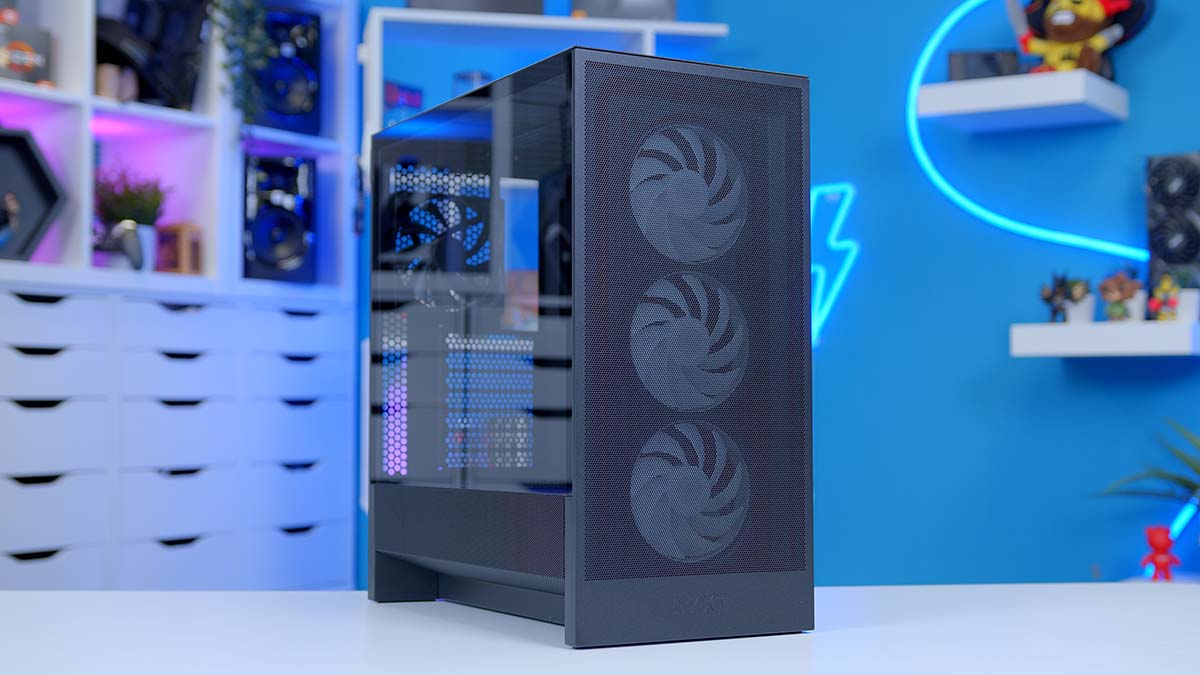
![FI_[DM76] HAVN BF360 5090 Build](https://geekawhat.com/wp-content/uploads/2025/10/FI_DM76-HAVN-BF360-5090-Build-1-551x431.jpg)
